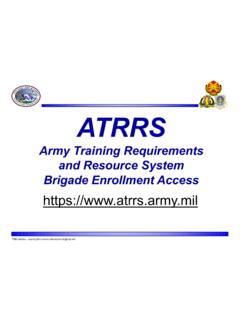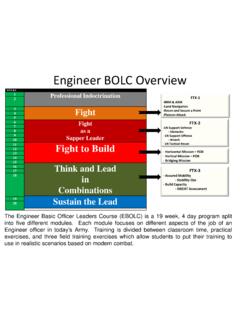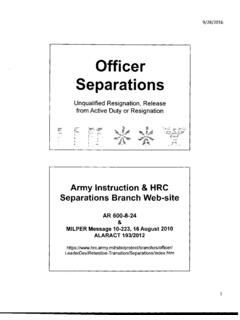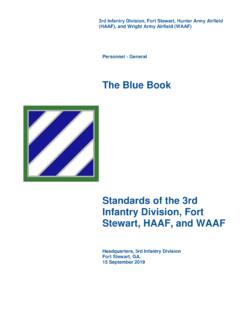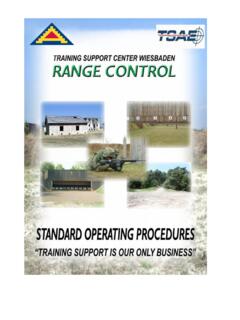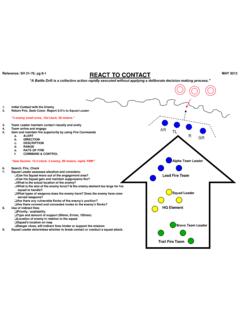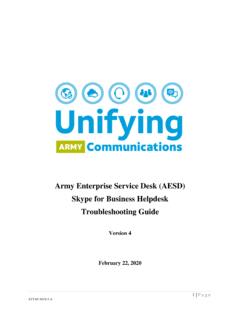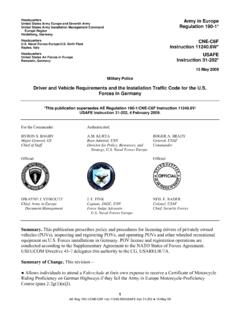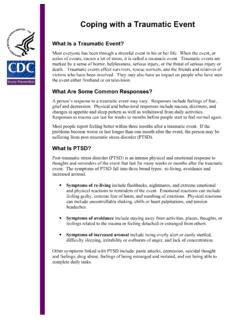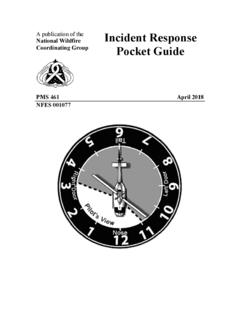Transcription of Chapter 6 Army Motor Vehicle/Privately Owned Vehicle ...
1 1 Chapter 6 Army Motor Vehicle /Privately Owned Vehicle accident Prevention Program 6-1. General a. Privately Owned Vehicle (POV) accidents are consistently the number one killer of Army Service Members. While commanders/supervisors do not control POV operators similar to those operating Army Motor vehicles (AMV), numerous areas of influence may be used to reduce manpower losses. The POV and AMV accident Prevention Program is provided for use in developing and implementing effective prevention and accident avoidance strategies.
2 B. Fort Lee has established a POV Task Force to address POV safety concerns. The POV Task Force members are the Installation Safety Office, DPW, PMO, Army Substance Abuse Program (ASAP), Public Affairs Office (PAO), and Staff Judge Advocate (SJA). The Installation Safety Office will convene the meetings quarterly. 6-2. Responsibilities The commander/supervisor is ultimately responsible for the implementation of effective AMV and POV accident prevention efforts within their commands. a. Unit and activity commanders will select, train, and license AMV drivers IAW DoDI , ARs 385-10, 600-55 and 190-5, and local policy.
3 B. The Installation Safety Office (ISO) will: (1) Provide staff oversight of the Motor Vehicle accident prevention program. (2) Maintain and disseminate Motor Vehicle safety awareness material. (3) Collect Motor Vehicle accident data and analyze data to identify accident trends and develop countermeasures. (4) Administer the Army Traffic Safety Training Program. (5) Chair and convene the POV Task Force meetings quarterly. c. The Provost Marshal Office (PMO) will: (1) Monitor speed limits and issue authorized citations for speeders.
4 (2) Provide POV accident data to the Installation Safety Office. (3) Periodically conduct seatbelt checks to determine installation compliance rates. (4) Conduct child safety seats inspections for the installation. 2 (5) Attend POV Task Force Meetings. d. The Army Substance Abuse Program (ASAP) will: (1) Maintain and disseminate alcohol and drug safety awareness material. (2) Attend POV Task Force meetings. e. First line supervisors will: (1) Ensure all operators of Army Motor or General Services Administration (GSA) vehicles successfully complete the CRC accident avoidance Training or equivalent every 4 years.
5 (2) Conduct/schedule driver training for assigned personnel. (3) Ensure that all newly assigned military personnel complete personal information sheets including individual driving history, and commander's interview within 30 days of arrival. (4) Use the "Next accident " scenario from the POV Risk Management Toolbox on the CRC website found at appendix A, section III, to assess the risk level of newly assigned personnel or to identify the at risk driver. (5) Following every fatal or serious injury POV accident , commanders will conduct an assessment of the accident with the involved Service Member's chain of command to determine what happened, why it happened, and how it could have been prevented.
6 F. Installation Transportation Officer will require operators to show to the dispatcher Fort Lee Form 1082, accident avoidance Training Card, or other valid means of accident avoidance training before dispatching the Vehicle . 6-3. Motor Vehicle training Army accident avoidance training is a proven means by which to raise safety awareness, change driver attitude/behavior, and improve driver skill. As a minimum the following training will be provided to appropriate personnel as needed at no cost to the individual Service Member or Civilian employee.
7 A. Army accident avoidance training. All military/Civilian operators of AMV or General Services Administration (GSA) Vehicle must successfully complete the online CRC Army accident avoidance course or equivalent and have a refresher course every 4 years thereafter. Website for this training is found at appendix A, section III. AKO access is required. b. Motorcycle safety. All Service Members operating a motorcycle, moped, or scooter will successfully complete the required Motorcycle Safety Foundation (MSF) Beginners Rider course and the Experienced Rider course .
8 Website for this training is at the US Traffic Safety 3 Training Program Registration, found at appendix A, section III. (Click Continue to this website. ) c. Remedial driver training. Drivers in military and/or GSA vehicles who have at-fault traffic accidents , commit a serious driving offense, misuse government vehicles, or are cited by police on or off post and found guilty of moving violations will attend remedial driver s training. Training consists of review of local hazards, intermediate drivers training, impact of laws, drinking and driving, speeding, cell phone distraction and seat belt polices.
9 D. Pre-holiday/special hazard driver awareness training. Supervisors will ensure every assigned Service Member and Civilian employee will be given special training or orientations/briefings before any 3-day weekend. The training must include a review of local driving laws/regulations, Motor Vehicle safety inspections, the effects of fatigue or alcohol on a driver s capabilities, and review of any local driving hazards. Commanders will ensure POVs of all military personnel are given a safety inspection prior to holidays as required by AR 385-10, at a minimum of every 6 months.
10 POV safety inspections are also required prior to a Service Member taking leave or pass if driving over 250 miles to his/her destination. Fort Lee Form 385-5, POV Inspection Checklist is at the back of this regulation. e. Tactical Vehicle and bus driver training. Driver training must be conducted by the unit in accordance with AR 600-55 and AR 385-10. The appropriate training circular in the TC 21-305-XX series will be the minimum standard for driver training programs. Bus driver training will be conducted by Transportation Motor Pool (TMP).
